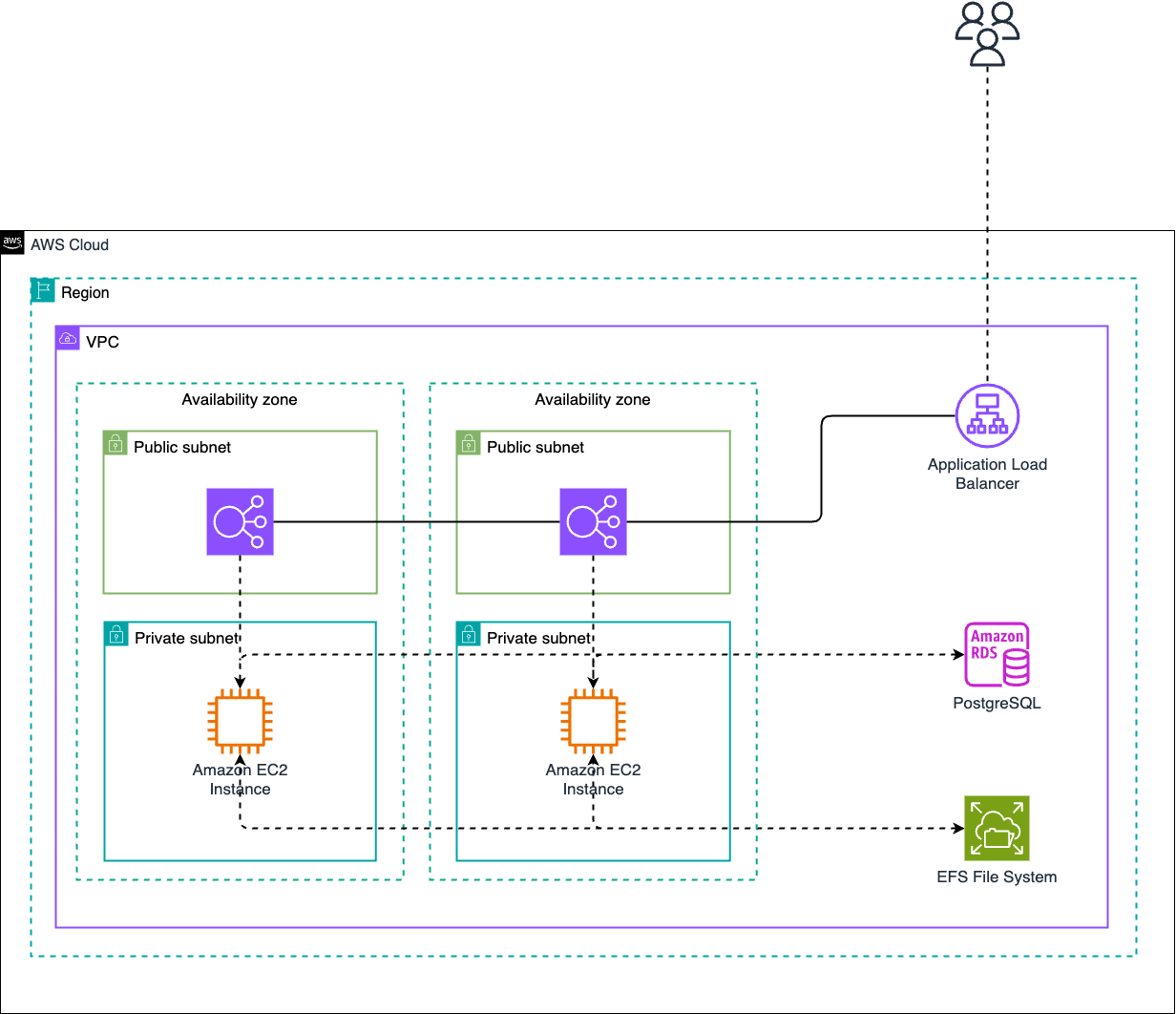Load Balanced
Posit Connect can be configured to run on AWS in a load balanced, high availability (HA) cluster configuration. This architecture is designed to provide high availability and fault tolerance for Connect, ensuring that the service remains available even in the event of a failure.
This architecture is best used when at least one of the following apply:
- There are internal high availability requirements
- Cost optimization is a priority, while still maintaining a resilient architecture
Architectural overview
This implementation of Posit Connect utilizes a High Availability configuration and includes the following components:
- AWS Application Load Balancer (ALB) to route requests to the Connect instances.
- Two AWS Elastic Compute Cloud (EC2) instances running Connect in a High Availability configuration.
- AWS Relational Database Service (RDS) for PostgreSQL, serving as the application database for Connect.
- AWS Elastic File System (EFS), a networked file system used to store file data, which is mounted across the Connect services.
Architecture diagram
Nodes
This architecture utilizes a high availability configuration with two EC2 instances running Posit Connect. During our performance tests, we used two m6i.2xlarge instances running Ubuntu 22.04.
The EC2 instances in an HA configuration require the following configuration:
- Matching versions of Posit Connect.
- Shared configuration file for every node.
- All the necessary versions of Python, R, and Quarto.
For detailed instructions on setting up this configuration, refer to the HA checklist in the Connect Admin Guide: HA Checklist.
Database
This architecture utilizes an RDS instance with PostgreSQL running on a db.m5.large instance, provisioned with a minimum of 15 GB of storage and running the latest minor version of PostgreSQL 16 (see supported versions). Both the instance type and the storage can be scaled up for more demanding workloads.
- The RDS instance should be configured with an empty PostgreSQL database for the Connect metadata.
Storage
This architecture utilizes an encrypted AWS Elastic File System (EFS). EFS does not require initial sizing as it autoscales with usage.
Load balancer
This architecture utilizes an AWS Application Load Balancer (ALB) in order to provide public ingress and load balancing to the Connect instances.
- The ALB must be configured with sticky sessions enabled
- You must configure health checks to ensure that the ALB routes traffic only to healthy nodes. This can be done by following the instructions in the Posit Connect Admin Guide.
Networking
The architecture is implemented in a virtual private cloud, utilizing both public and private subnets across multiple availability zones. This setup ensures high availability and fault tolerance for all deployed resources. The RDS database instance, EFS mount targets, and the EC2 instances are located within the private subnets and ingress to the EC2 is managed through an ALB.
Configuration details
The required configuration details are outlined in multi-server installation steps. More information on running Posit Connect behind a proxy can be found in the Running with a Proxy page.
Resiliency and availability
This implementation of Connect is resilient to within-AZ failures. With two nodes of Connect, a failure in either node results in disruption to user sessions on the failed node, but does not result in overall service downtime.
We recommend using proper backup and disaster recovery procedures with the RDS and EFS instances of the cluster.
Performance
The Connect team conducts performance testing on this architecture using the Grafana k6 tool. The workload consists of one virtual user (VU) publishing an R-based Plumber application repeatedly, while other VUs are making API fetch requests to a Python-based Flask application.
The first test is a scalability test, where the number of VUs fetching the Flask app is increased steadily until the throughput is maximized. After noting the number of VUs needed to saturate the server, a second “load” test is run with that same number of VUs for 30 minutes, to accurately measure request latency when the server is fully utilized.
Below are the results for the load test:
- Average requests per second: 2329 rps
- Average request latency (fetch): 147 ms
- Number of VUs: 400
- Error rate: 0%
(NOTE that k6 VUs are not equivalent to real-world users, as they were being run without sleeps, to maximize throughput. To approximate the number of real-world users, you could multiply the RPS by 10).
Please note that applications performing complex processing tasks will likely require nodes with larger amounts of CPU and RAM to perform that processing, in order to achieve the same throughput and latency results above. We suggest executing performance tests on your applications to accurately determine hardware requirements.
FAQ
See the Architecture FAQs page for the general FAQ.
